How do we know? They confirmed it a couple of years ago.
Pages with lots of backlinks also tend to get more traffic from Google, according to our study.

From our study of ~1 billion pages
But how do you find replicable, needle-moving backlinks anyhow?
The secret to finding backlinks that help you rank in Google
Find out where your competitors get their links from, then replicate them.
Not sure who your competitors are? They’re the sites that already rank high in Google for the search queries you want to rank for. Your job is to find (and replicate) the backlinks that helped them get there.
Use the Competing domains report in Site Explorer to see the sites that compete with yours in the SERPs.
Site Explorer > enter your domain > Competing domains
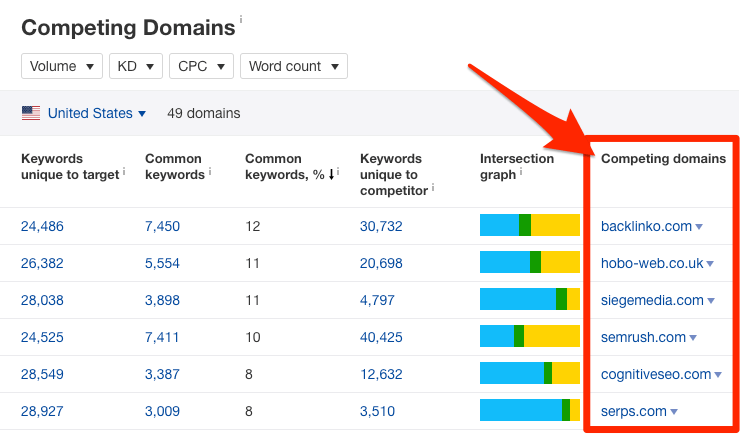
Via the Competing Domains report in Ahrefs Site Explorer
Keep in mind that this will only work with established sites. If your site is new and doesn’t yet rank for anything, you may not see great results here.
For us, one competing site would be backlinko.com as it ranks for a ton of search terms that we want to rank for. Same goes for moz.com.
But how do we know where their backlinks come from?
How to find backlinks (to any webpage or website)
- Go to Ahrefs Site Explorer;
- Paste in any URL or domain (e.g., https://competitor/blog/blog-post/ or https://competitor.com)
- Select the “exact URL” (for web pages) or “*.domain/*” (for websites) mode from the drop-down;
- Go to the Backlinks report (on the left-hand menu)
You’ll then see backlinks pointing to your chosen website or webpage, plus lots of data, including:
- Referring page (where the link comes from);
- Anchor text (the clickable words that link to the target page);
- Traffic (estimated Google search traffic to the linking page);
- First seen (when we first saw the link)

Backlinks to this page, via Ahrefs Site Explorer
This data comes from Ahrefs’ industry-leading backlink database which contains 212 BILLION pages. It was built by crawling the web and is updated every 15-30 minutes. We also crawl 4.1 million pages every minute!
We crawl so fast, in fact, that Ahrefs’ crawler outperforms Bing, Yahoo, and Yandex.
The bottomline? You can use the Backlinks report Site Explorer to check backlinks to any website or web page. So if you enter a competitor’s site, you’ll see all their backlinks.
How is this useful? Because some of your competitor’s links helped them to rank well. Your job is to find those links and replicate them.
But this report often uncovers hundreds of thousands of backlinks….
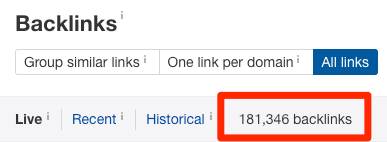
… so how do you know which ones are potentially replicable?
How to find replicable backlink opportunities from your competitors
You should always research backlinks on a page-by-page basis. This is crucial.
I repeat: if your goal is to steal backlinks, do not look at the backlinks pointing to a competing website as a whole. You won’t learn much from this. Always start by researching the page from which you’re trying to replicate backlinks.
How do you choose a page to research?
It comes down to your circumstances and goals.
- If you want to build links to existing content on your site, start by finding similar content that already has backlinks. For example, if we wanted to build links to our list of SEO tips, we’d start by researching a similar list of tools that has some backlinks, like this one.
- If you want to create new content with the goal of attracting links, start by studying what works for competitors. For example, if we were doing this for ahrefs.com, we may start by researching what kind of content attracted the most links for a site like backlinko.com or moz.com.
Let’s take a look at how to find replicable backlinks in each of these cases.
Step 1. Find a relevant page with lots of backlinks
Let’s assume that we want to build backlinks to ahrefs.com but we don’t yet have any content.
First, we need to find a page that has a lot of backlinks. We’ll then take inspiration from this page and create something similar, but better. Finally, we’ll use this newly-created content to replicate some of the links to the original page.
To start, let’s see which pages attracted the most backlinks for one of our competitor’s, moz.com. For this, we’ll use the Best by Links report in Site Explorer.
Site Explorer > enter a competing domain > Pages > Best by Links > add a HTTP 200 filter
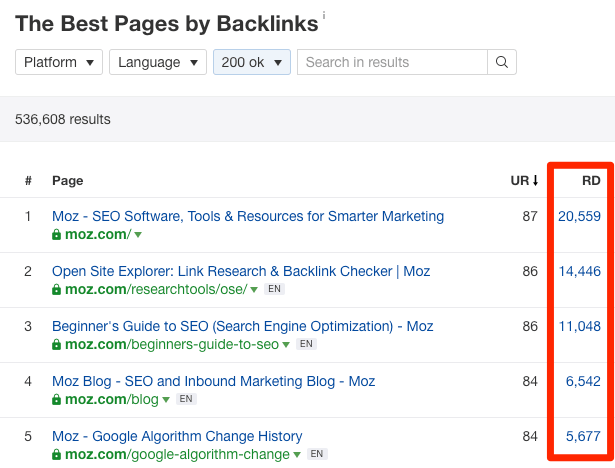
In this particular case, you’ll notice that some of these pages are irrelevant given the task at hand. We don’t want product and service pages included here; we only want to see links to content on their blog.
To do this, we can use the “prefix” mode in Site Explorer. This restricts data to only a subsection of a website (e.g., moz.com/blog*).

Here’s one of the pages that popped up in the Best by Links report for moz.com/blog:

It has over 2,500 backlinks from 1,021 referring domains.
I’m pretty sure we could create something similar to (and better than) this, don’t you!?
It’s not always necessary to create a better version of an exact page. You could also use this report to find out what type of content is likely to attract backlinks, then create something slightly different.
For example, a lot of the most-linked-to pages on backlinko.com are studies.

So, if we were trying to create content that attracts backlinks for ahrefs.com, creating an experiment or case study would be the best course of action.
But we don’t even have to “copy” these exact topics.
For example, instead of effectively “skyscrapering” that voice search SEO study (see screenshot above), which focuses on Google Home optimization, we could instead do a similar study for Alexa voice search. People who link to the voice SEO study will likely be open to linking to our Alexa study because it adds value to the conversation.
Alternatively, we could create a super in-depth guide to the role schema markup plays in voice SEO. This is something Brian mentions in his voice SEO study, but he doesn’t go into much detail about it. I’m sure people who linked to Brian’s guide would also be willing to link a post that expanded on this point.
But what if we already had a page to which we wanted to build backlinks, such as our on-page SEO guide? This would require a different approach, as we’d instead need to find similar pages that already have backlinks.
We could do this by Googling the topic of our page, then pasting each of the top 10 pages into Site Explorer to see how many backlinks they have…
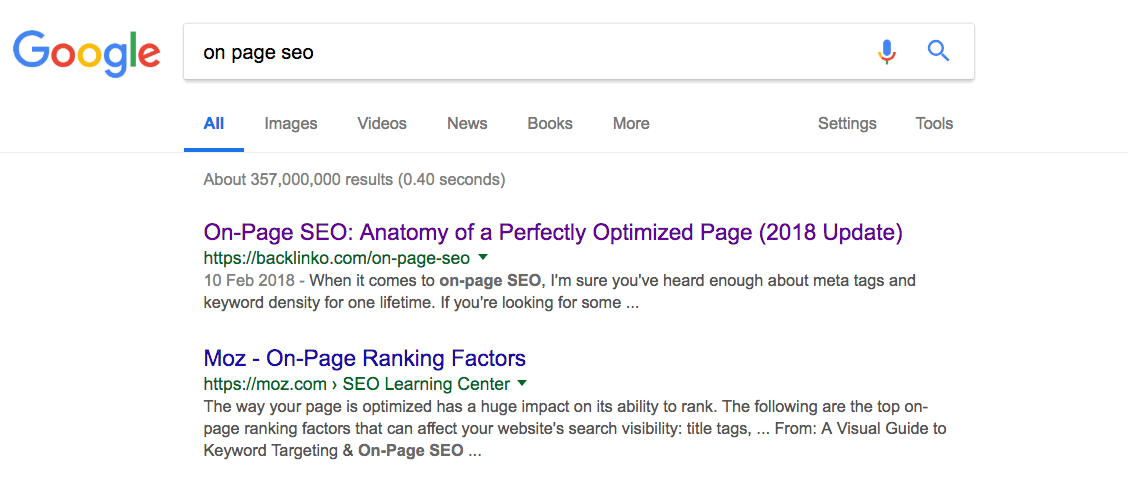
… but that’s a bit long-winded, so I prefer to use the SERP overview in Keywords Explorer which shows backlinks to all the top 10 pages at once.
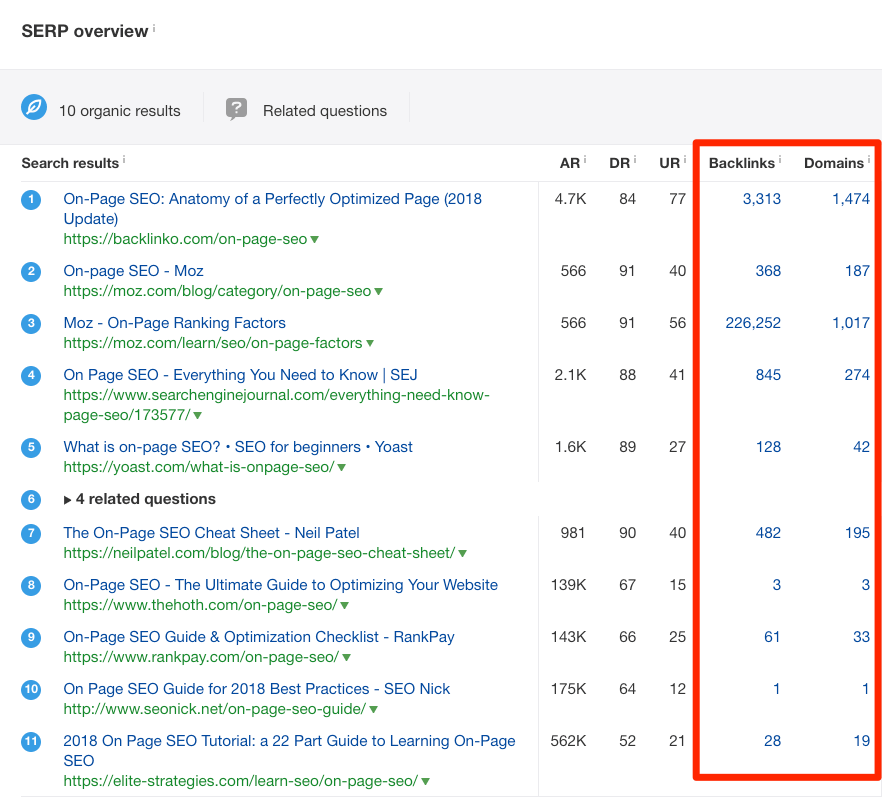
Want to see the backlinks for the top-100 pages?
Change your Google search settings so it shows the top 100 results, scrape them, paste them into Ahrefs Batch Analysis tool, then sort by referring domains.

We can also find relevant pages with lots of backlinks using Content Explorer.
Content Explorer is like a mini-search engine powered by a database of almost one BILLION pages. Search for something and it’ll kick back all the pages that mention that term in the content (or in their title tag, if you select that option, which I recommend).
How is this useful?
Because you can then use Content Explorer’s inbuilt filters to instantly sort and filter the results by the amount of backlinks they have. In other words, you can see the most linked-to pages on your topic. Here’s how to do it:
Content Explorer > enter a search term > select “In title” from the drop-down (optional - it just usually gives more relevant results) > sort the results by the referring domains
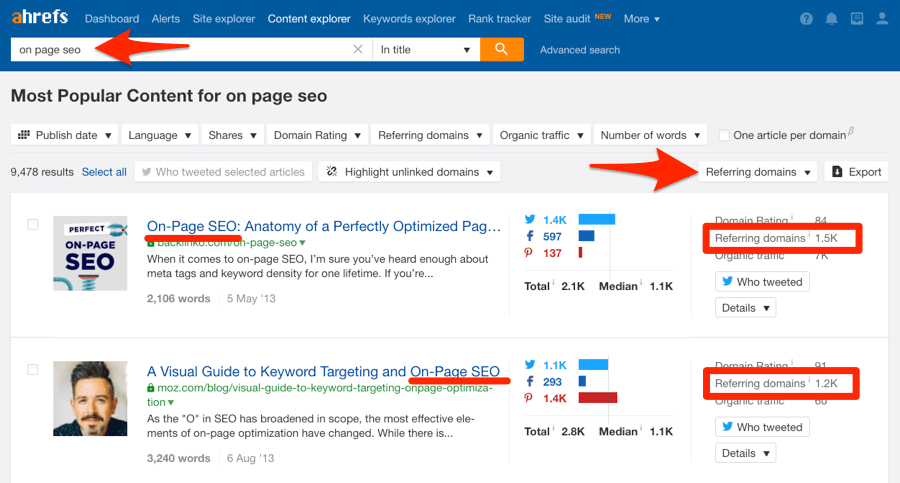
You can see that we got 9,478 results for “on page seo,” one of which happens to come from our competitor, backlinko.com.
Being as we already have a similar page to this, I’ll stick with this example for the rest of the article.
Once you’ve found a page from which you want to replicate backlinks, paste the URL into Site Explorer and go to the Backlinks report. You’re now going to examine the backlinks for this page (and any other relevant pages you found) one by one.
Don’t get scared if you’re seeing a lot of backlinks in this report. You won’t have to analyse all these. You’re first going to filter down this list so that you only need to analyse backlinks that:
- You actually want;
- Are actually possible to replicate.
Let’s do this!
Step 2. Filter and sort the backlinks
Link prospecting cannot be fully-automated. Some degree of manual vetting is always required.
But what if the backlinks report for the page you’re viewing looks like this?
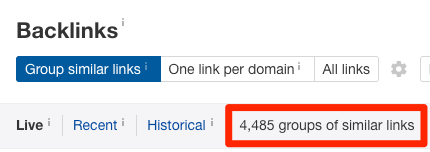
Nobody has the time to manually vet that many links, right? You don’t need to.
The truth is that a lot of the links won’t be worth pursuing, such as those that are low-quality, nofollowed, or from foreign-language pages.
Filter these out by adding the following filters:
- Language → English
- Link type → Dofollow
- Platform → Blogs
That last filter is an important one. It filters for links that appear on blogs, which are almost always in-content editorial links. These are the powerful links that everyone wants.
You may also want to sort the links by traffic (high to low) so that you’re prioritising links from pages with the most traffic. Here’s why:
- It’s rumoured that Google sees backlinks from pages with significant traffic as more valuable. If Google is sending traffic to the linking page, then they must see that page as valuable. So, although Google has never confirmed it, I do think it would make sense that any pages associated with these “proven” pages are also seen as high-quality by power of association.
- It will lead to more referral traffic. Remember that the original point of links has nothing to do with SEO. They provide a way for people to navigate the web. You click a link, it takes you to a destination. That’s why it’s called a link. The more traffic the referring page has, the greater the chance that someone will click on your link and land on your site. This is known as referral traffic.
- It will lead to more links on autopilot. No matter what tactic you’re using to attract backlinks, the starting point is always the same: the potential linker first has to become aware that your content exists. Negate this first step and there’s no possible way they can link to it, no matter how great it is. Links on pages with lots of traffic will get your content in front of more eyeballs which, in turn, leads to more links.
Here’s what your list should look like once filtered:
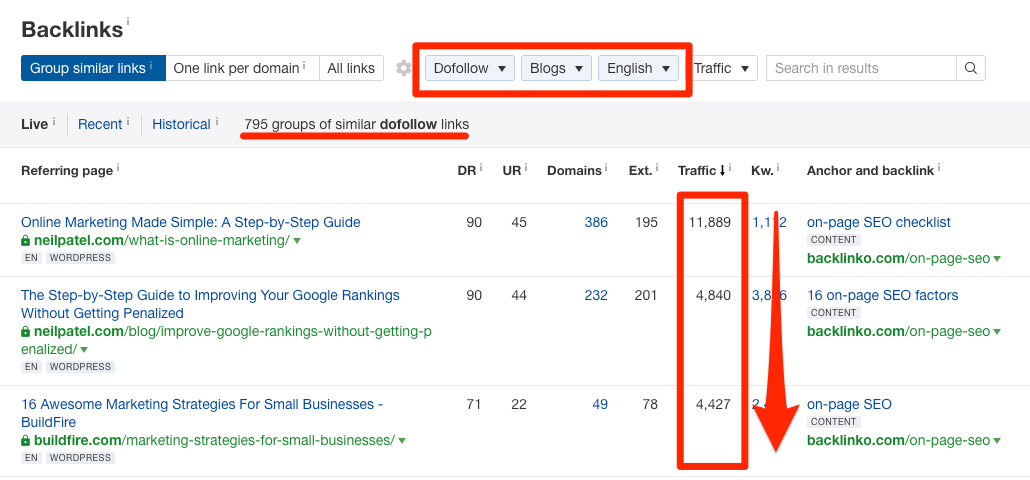
You’ll notice that there are already far fewer backlinks to vet: 795 rather than 4,485. This is a much more manageable number.
Step 3. Find replicable links
At this stage, you should have a filtered, junk-free list of backlinks that you may want to replicate. So now let’s tackle the other part of the equation: finding the links that are actually “replicable.”
This is where a lot of so-called marketers get lazy.
Many just export this report and hit everyone with some blanket outreach along the lines of:
“Hey [Name],
I was just looking for some content about [topic] and saw your guide: [insert URL]
Great stuff!
I recently published a guide about [topic] and thought you might like to check it out. Here’s the link: [insert your URL]
What do you think? Perhaps this would make a nice addition to the post?
Thanks,
Scummy marketer”
Don’t do this. Your conversion rate will be very low. You’ll annoy people. And you’ll burn bridges.
So what should you do?
Work your way down your filtered list and:
- Look at the context of the link, to understand why it was given (hint: look to the “referring page” and “anchor and backlink” columns for this);
- Figure out if, and how, swapping out or adding your link will add value to the linking page.
Did you notice that I bolded the word “if” in that second point? That’s because it’s not always appropriate to ask the author to swap out the existing link in favor of yours, or even add your link to the page.
You should only ask if there’s a compelling reason to do so. That’s why it’s so important to understand the context of the link and the reason it was given.
This can be somewhat difficult, so here are a few common reasons people link contextually:
- Recommendation;
- Source link;
- Existing relationship;
- Paid link
If you can identify which one of these was the catalyst for the link, then you can often figure out how to replicate it.
Let’s take a look at each of these in more detail.
1. Recommendation
These links recommend a resource, but not explicitly. Rather, they’re linked contextually within the natural flow of the article. Like this:

You can spot these by looking at the anchor and surrounding text in the “anchor and backlink” column. If the link exists within a sentence, it’s a contextual recommendation.
These are generally regarded as the best links one can get.
The problem? Replicating them can be rather difficult.
Bloggers usually link in this way when they’re a fan of a specific article, so a quick “hey, our post is better, can u link to that instead pls?” isn’t going to cut it.
You’re going to need a real compelling reason to get them to do a like for like swap on the link, such as:
- The article they’re currently linking to is broken (i.e., broken link building);
- The article they’re currently linking to is drastically inaccurate and/or out of date;
- The article they’re currently linking to is categorically worse than your article, by a long shot (i.e., the “skyscraper” approach).
If any of those apply, feel free to go for it with a direct pitch.
Otherwise I recommend a less more subtle approach, whereby you:
- Find something unique about your article. Did you talk about something that your competitor didn’t? Did you offer a unique viewpoint? Did you disprove something they said? You can usually find something.
- Use that as a “soft pitch.” Let the author of the linking page know about your article via email. Don’t ask for a link. Just say that you saw they mentioned X in their article and that they might be interested in reading Y, because [insert unique angle here].
The aim here isn’t to convince them to swap out the link. It’s to introduce them to your content and spark a relationship.
People link to others that they know and like, so it’s well worth building relationships with those who regularly link out to other blogs in their niche.
(I’ll show you a hack for taking this further later in the guide.)
That way, they may link to you in future.
And yes, this is a long-term play. Honestly, that’s pretty much the only way you will get truly great links.
2. Source links
Articles with unique statistics, graphics, facts or ideas will often attract so-called source links, like this:

You can see from looking at the anchor and surrounding link text that the author quoted a fact from this post. They linked back (contextually) as the source of the data.
But it’s not just stats that result in “source” links. Sometimes it’s an image attribution link…

… or a definition…

… or even just an idea…

Here are some ideas for replicating these links:
- Newer statistic. Do you have a more up to date statistic about the same thing in your article? Then you’re onto a winner. Nobody wants to link to out of date stuff, so reach out and tell the author that they might want to switch this out and link to something more up to date;
- Prettier graphic. Is the graphic they’ve embedded ugly? Is it low-quality? Send them a better replacement;
- Better definition. Does it make sense? Is there a better definition in your article that would be a better replacement? Tell them.
But here’s the thing: these ideas can work, but only in quite specific circumstances.
Your best bet with source links is to take a more holistic approach and look for trends. If you notice that a competing article has lots of source links for a specific reason (e.g., lots of people embedding a graphic from the post), you may want to refine your content with this in mind.
If a high percentage of links are the result of image embeds, include a similar image in your post.
If they’re the result of a definition being quoted, add a definition to your post too.
If most of the links occur because of a statistic… well, you get the idea!
3. Existing relationship
People link out to others that they know and like. It’s just human nature.
But how do you spot whether a site has a relationship with another site by looking at the Backlinks report?
You can’t. For this, you need to enter your competitor’s domain (yes, domain!) into Site Explorer and check the Referring domains report. This will show you all the unique sites that are linking to your competitor’s domain and, crucially, how many times they’ve each linked.
Site Explorer > enter competing domain > Referring domains > add dofollow filter > sort by “links to target”

You can then scan through this report looking for domains that you recognise, or even just domains that sound legit and relevant. Ignore any junk.
I did this for backlinko.com and instantly, I spotted this:

No, your eyes don’t deceive you. That’s 2,500+ links from neilpatel.com to backlinko.com.
It doesn’t take a genius to work out that Neil must be a big fan of Brian. He clearly respects his work… enough to link to it 2.5K times, apparently!
How does this help you? These are the people with whom it pays to build relationships, as they publish a lot of content and have a tendency to link out to the same sites over and over again.
That’s not to say that this should be your only reason for doing this. Build relationships with people that you like and admire. Don’t fake it just for links!
4. Paid links
Paid links are, well paid links. People buy these links from bloggers for an average price of $361.44.
These can be somewhat difficult to spot at times, but a few telltale signs are:
- Exact-match anchor text;
- From a “guest post”;
- Very few other external links on the page;
- Unnaturally placed—i.e., shoehorned where it doesn’t really belong.
It probably goes without saying that you shouldn’t try to replicate these links.
I just wanted to mention this one briefly as you need to be aware of it. Otherwise, you can waste a lot of time.
If you reach out to a blogger and they ask for money, make a note not to contact that website again and move on. Chances are your competitor paid for a link from that site, and that’s not a game we recommend you get involved in.
5. Other
Are the four reasons above all-encompassing? Not at all.
You should always judge each link individually. If you’re unsure about the context or reason for the link, click through and visit the actual linking page. Hit CTRL/CMD+F and search for the anchor text.

This is sometimes the only way to understand the real reason a link was given.
Take this link, for example:

We know where it links from and to, but the word “here” as the anchor text doesn’t tell us anything about why this link exists.
But if we look at the linking page, it becomes instantly clear.

The author used the “content upgrade” from Brian’s post as an example in his article.
Is this link replicable? Not for us. But if you happen to have a so-called content upgrade in your post, it may make sense to reach out and offer this as another example for inclusion in the post. (It’s probably worth building up a relationship before doing that, though).
Can you rank without backlinks?
Yes, it is possible. But it’s rare.
How do we know? Because there’s a positive correlation between the number of referring domains to a page and the number of keywords it ranks for (in the top 100).

But what if there was a way to identify topics you may be able to rank for with few or no backlinks? That would be cool, right?
Enter: Content Explorer (again!)
Just to refresh your memory, Content Explorer is like a mini search engine built into Ahrefs. It runs off our database of almost one BILLION pages. You use it the same way you would Google. Type something in and we’ll kick back any pages that mention your keyword(s) from our database.

But for this hack, we also need to add a few filters.
- Estimated monthly organic traffic: > 500;
- Referring domains: <5
- Language: English
This filters for pages that have few referring domains (backlinks) and at least five-hundred monthly visits from Google.
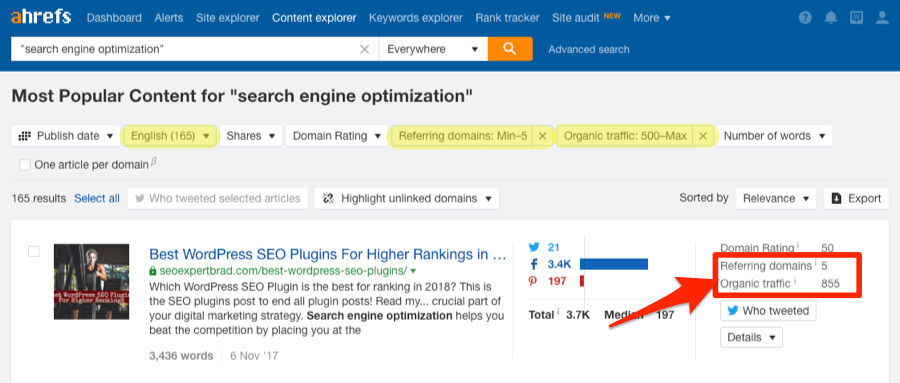
You should be able to rank for these topics without the need for many backlinks at all.
Watch Sam Oh’s video to learn about even more cool Content Explorer hacks.
Final Thoughts
Backlinks aren’t always easy to replicate, especially the needle-moving ones.
But that’s a good thing. It’s difficult for everyone, not just you. This creates a level-playing field where rankings are dictated primarily by content quality.
That said, it’s not enough to simply create high-quality content. People also need to know it exists, especially those with the power to link. This is where blogger outreach comes in.
Want more actionable ways to steal your competitors’ links? See our list of seven actionable ways to loot your competitors backlinks.





